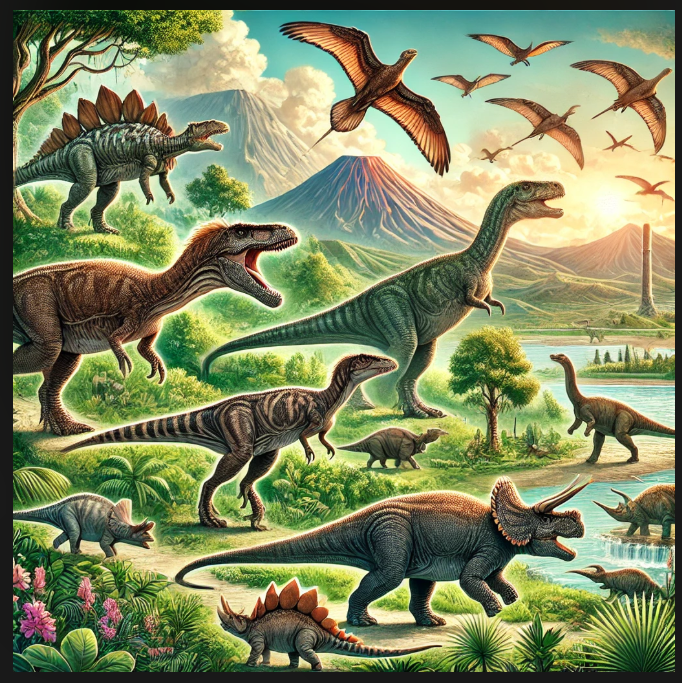Dinosaurs were a group of reptiles that dominated Earth’s terrestrial ecosystems for over 160 million years, from the Late Triassic period (about 230 million years ago) to the end of the Cretaceous period (about 66 million years ago). Their history can be divided into three main periods:
1. Triassic Period (230-201 million years ago):
- Dinosaurs first appeared during the late Triassic period, but they were not the dominant group of animals at the time. Early dinosaurs were relatively small, bipedal, and carnivorous.
- The climate was hot and dry, and the Earth was still a supercontinent, Pangaea, which began breaking apart toward the end of the period.
2. Jurassic Period (201-145 million years ago):
- The Jurassic period is considered the “golden age” of dinosaurs. The climate was more humid and warm, and Pangaea continued to break apart, creating more varied environments.
- Many of the most famous dinosaurs, like Stegosaurus, Brachiosaurus, and Allosaurus, lived during this time. Large, long-necked herbivores and powerful carnivores dominated the land.
- The first birds also evolved during this period, with Archaeopteryx being one of the earliest known birds.
3. Cretaceous Period (145-66 million years ago):
- The Cretaceous period saw the peak of dinosaur diversity. Massive herbivores like Triceratops, Tyrannosaurus rex, and Hadrosaurus roamed the Earth, while smaller, more agile carnivores continued to thrive.
- Flowering plants evolved, changing the landscape and providing new food sources.
- Around 66 million years ago, the mass extinction event (likely caused by an asteroid impact and volcanic activity) wiped out the non-avian dinosaurs, marking the end of the Cretaceous period.
After the Extinction:
- The extinction of the dinosaurs allowed mammals to rise and eventually dominate the Earth. However, birds, which evolved from theropod dinosaurs, are considered the only surviving descendants of the dinosaur lineage.
Dinosaurs were incredibly diverse, and their fossils continue to provide valuable insight into Earth’s prehistoric past. The study of dinosaurs is essential to understanding evolutionary biology and the history of life on Earth.
What dinosaur has 500 teeth
The dinosaur known to have around 500 teeth is the Hadrosaurus, a type of duck-billed dinosaur from the Late Cretaceous period. Hadrosaurs are known for their complex, flat teeth that were perfect for grinding plant material. Some species of hadrosaurs, such as Edmontosaurus and Parasaurolophus, had up to 500 teeth, which they used for processing large amounts of vegetation.
The teeth of these dinosaurs were arranged in a way that allowed them to effectively chew their food, a characteristic that helped them become some of the most successful herbivores of their time. They had multiple rows of teeth that continuously replaced worn-out teeth, allowing them to maintain their ability to feed efficiently on tough plants.



